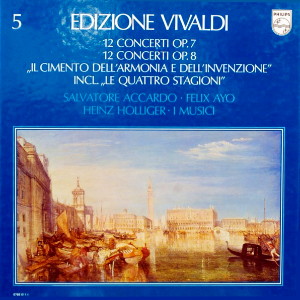 |
|
5 LP's
- 6768 011 - (c) 1978
|
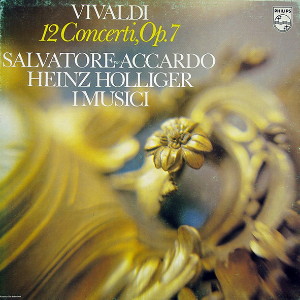 |
| 2 LP's -
6700 100 - (p) 1976 |
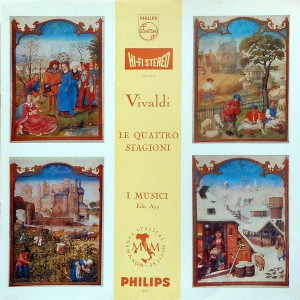 |
| 1 LP -
835 030 - (p) 1959 |
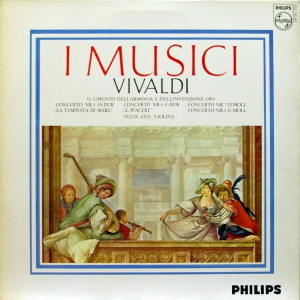 |
| 1 LP -
835 109 - (p) 1962 |
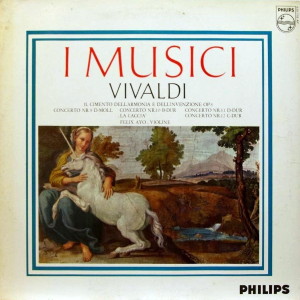 |
| 1 LP -
835 110 - (p) 1962 |
|
| EDIZIONE
VIVALDI - Vol. 5 |
|
|
|
|
|
|
|
| Antonio
Vivaldi (1678-1741) |
|
|
|
|
|
|
|
| Long Playing
1 |
|
51' 53" |
|
12 Concerti für
Violine oder Oboe, Streicher und
Continuo op. 7
|
|
|
|
| -
Concerto Nr. 1 B-dur für Oboe, RV/R.
465 (P. 331) |
6' 35"
|
|
|
| -
Concerto Nr. 2 C-dur für Violine,
RV/R. 188 (P. 5) |
9' 13" |
|
|
| -
Concerto Nr. 3 g-moll für Violine,
RV/R. 326 (P. 332) |
8' 12" |
|
|
|
|
|
|
| -
Concerto Nr. 4 a-moll für Violine,
RV/R. 354 (P. 6) |
10' 02" |
|
|
| -
Concerto Nr. 5 F-dur für Violine,
RV/R. 285a (P. 255) |
9' 35" |
|
|
| -
Concerto Nr. 6 B-dur für Violine,
RV/R. 374 (P. 333) |
8' 16" |
|
|
Long Playing
2
|
|
52' 40" |
|
| -
Concerto Nr. 7 B-dur für Oboe, RV/R.
464 (P. 334) |
6' 45" |
|
|
| -
Concerto Nr. 8 G-dur für Violine,
RV/R. 299 (P. 102) |
7' 38" |
|
|
| -
Concerto Nr. 9 B-dur für Violine,
RV/R. 373 (P. 335) |
11' 26" |
|
|
|
|
|
|
| -
Concerto Nr. 10 F-dur für Violine,
RV/R. 294a (P. 256) |
8' 46" |
|
|
| -
Concerto Nr. 11 D-dur für Violine,
RV/R. 208a (P. 151) |
10' 50" |
|
|
| -
Concerto Nr. 12 D-dur für Violine,
RV/R. 214 (P. 152) |
7' 15" |
|
|
| Long Playing
3 |
|
43' 58" |
|
12
Concerti für Violine, Streicher
und Continuo op. 8 "Il Cimento
dell'armonia e dell'inventione"
|
|
|
|
| -
Concerto Nr. 1 F-dur "La primavera",
RV/R. 269 (P. 241) |
11' 21" |
|
|
| -
Concerto Nr. 2
g-moll "L'estate",
RV/R. 315 (P. 336) |
10' 34" |
|
|
|
|
|
|
| -
Concerto Nr. 3 F-dur
"L'autunno", RV/R.
293 (P. 257) |
12' 22" |
|
|
| -
Concerto Nr. 4
f-moll "L'inverno",
RV/R. 297 (P. 442) |
9' 41" |
|
|
| Long Playing
4 |
|
37' 33" |
|
| -
Concerto Nr. 5
Es-dur "La tempesta
di mare", RV/R. 253
(P. 415) |
9' 12" |
|
|
| -
Concerto Nr. 6 C-dur
"Il piacere", RV/R.
180 (P. 7) |
9' 38" |
|
|
|
|
|
|
| -
Concerto Nr. 7 d-moll,
RV/R. 242 (P. 258) |
8' 21" |
|
|
| -
Concerto Nr. 8 g-moll,
RV/R. 332 (P. 337) |
10' 22" |
|
|
| Long Playing
5 |
|
41' 44" |
|
| -
Concerto Nr. 9 d-moll,
RV/R. 236 (P. 259) |
8' 23" |
|
|
| -
Concerto Nr. 10
B-dur "La caccia",
RV/R. 362 (P. 338) |
9' 36" |
|
|
|
|
|
|
| -
Concerto Nr. 11
D-dur, RV/R. 210 (P.
153) |
13' 24" |
|
|
| -
Concerto Nr. 12
C-dur, RV/R. 178 (P.
8) |
10' 21" |
|
|
|
|
|
|
| Concerti op. 7 |
Concerti op. 8
"Il Cimento dell'armonia e
dell'inventione"
|
|
| Salvatore Accardo,
Violine |
Felix Ayo, Violine |
|
| Heinz Holliger,
Oboe |
I MUSICI |
|
| I MUSICI |
|
|
|
|
|
|
Luogo
e data di registrazione |
|
La
Chaux-de-Fonds (Svizzera) - luglio
1975 (op. 7)
Vienna (Austria) - aprile 1959
(op. 8, 1-4)
Roma (Italia) - settembre 1961
(op. 8, 5-12)
|
|
|
Registrazione: live /
studio |
|
studio |
|
|
Producer / Engineer |
|
- |
|
|
Prima Edizione
originale LP |
|
Philips
- 6700 100 - (2 LP's) - durata 51'
53" | 52' 40" - (p) 1976 -
Analogico - (op. 7)
Philips - 835 030 - (1 LP) -
durata 43' 58" - (p) 1959 -
Analogico - (op. 8, 1-4)
Philips - 835 109 - (1
LP) - durata 37' 33" - (p) 1962
- Analogico - (op. 8, 5-8)
Philips - 835 110 - (1
LP) - durata 41' 44" - (p) 1962
- Analogico - (op. 8, 9-12)
|
|
|
Note |
|
-
|
|
|
|
|
|
|
Leaving
aside a dozen concertos
published individually, in
all probability without
the composer’s authority,
during his lifetime and
shortly after, Vivaldi had
nine sets of concertos
engraved in Amsterdam
between 1711 and 1730.
These collections can be
divided into two groups.
The first group comprises
four sets (Op. 3, 4, 8,
and 9) dedicated to some
“person of quality” and
prefaced by a letter of
dedication. All of them
contain 12 works and have
a fanciful collective
title such as “L’Estro
armonico” or “Il Cimento
dell’armonia e
dell’invenzione.” It
is probable that Vivaldi
paid for their engraving
out of his own pocket and
trusted to the generosity
of the dedicatee for a
defrayal of his expenses.
The second group comprises
five sets (Op. 6, 7, 10,
11, and 12) with no
dedication. Except for Op.
7 they contain a mere six
works and have prosaic
titles such as “Concerti a
cinque stromenti“
(Concertos in five
instrumental parts), the
title of both Op. 6 and
Op. 7. One assumes that
the initiative for their
publication came from
Amsterdam and that the
publisher bore all the
costs, including the
composer’s payment.
Indeed, the imprint of Op.
10-12 informs us that
publication was undertaken
at the expense of Michel
Charles Le Cene, head of
the renowned Amsterdam
firm. While Op. 6 and 7,
published around 1716-17
under the name of Jeanne
Roger, Le Cène’s
predecessor, are not
explicit on this point,
they seem to conform to
the same pattern. Vivaldi
eventually found this
“commissioned” type of
publication
unsatisfactory; in 1733 he
confided to an English
visitor that he had
decided not to send any
more compositions to
Amsterdam, since published
works diminished the
market for his more
profitable trade in
manuscripts!
The distinction between
collections with and
without a dedication would
be of little consequence
if it did not explain, at
least in part, some
important musical
differences between the
works in each category.
Because the dedicated
collections were intended
to appeal to the taste of
the dedicatee as much as
to that of the general
public, they tend to
possess a consistent,
well-defined character.
Thus the works in "La
Stravaganza." Op. 4 (c.
1714), which is dedicated
to Vivaldi’s pupil Vettor
Dolfin, a Venetian noble,
are particularly
adventurous in harmony (a
quality much prized by the
Venetians), while “La
Cetra,“ Op. 9 (1727),
dedicated to Emperor
Charles VI,
cultivates an unusually
lyrical species of
virtuosity. By comparison
the works in the
undedicated sets are
disparate in character and
uneven in quality.
Vivaldi’s publisher, and
no doubt the composer
himself, knew that the
enthusiastic amateurs of
north-west Europe, who
would form a large part of
the market, would not
exercise the
connoisseurship of a
Venetian patrician or an
Austrian monarch, but
would respond favourably
to a more catholic
selection of works, from
which obvious aesthetic or
technical difficulties
were excluded.
CONCERTOS, OP. 7
Perhaps it was the
publisher who suggested to
Vivaldi that each of the
two libri
(volumes) making up Op. 7
should be headed by an
oboe concerto. In
1715 the firm of Roger had
brought out a very popular
collection of concerti
a cinque by another
Venetian, Tomaso Albinoni
(1671-1751), which
contained several oboe
concertos, at that time a
novelty in the published
repertoire. The two oboe
concertos Vivaldi included
in his own Op. 7 conform
to some extent to the
rather old-fashioned
Albinonian conception of a
concerto “with” rather
than “for” oboe, where the
wind instrument’s role is
often more one of
partnership than
dominance. Most of
Vivaldi’s oboe concertos
published subsequently, as
well as the many which
remained in manuscript,
are more straightforwardly
soloistic in character -
more akin to violin
concertos, in fact. So
perhaps these two
concertos are among
Vivaldi's earliest for
that instrument, which had
been taught since 1707 to
the girls of the Ospedale
della Pietà,
the charitable institution
with which he was closely
associated for much of his
life.
The 10 violin concertos of
Op. 7 all employ
ritornello form in their
first movements: a tutti
ritornello (or refrain)
appears at intervals in
various keys, the bridging
passages (commonly called
episodes) being given over
to the soloist. The second
movements display more
variety. Five (Nos. 3, 7,
8, 10, and 11) are in a
simple unitary
(throughcomposed) form.
Two (Nos. 4 and 9) feature
in addition a running
dialogue between soloist
and tutti, while a
further two (Nos. 1 and
12) are in a rudimentary
ritornello form. Binary
form is used in No. 2 and
also, with varied repeats,
in No. 6. The fifth
concerto has a tripartite
central movement recalling
earlier examples by
Torelli and Albinoni. The
accompaniment in solo
passages is even more
diverse. Where single-line
accompaniments are
preferred, there is a
choice between the full
string ensemble with
continuo, each instrument
playing in the appropriate
octave (No.
10), upper strings alone
(Nos. 7, 8, and 12), and
simple continuo (Nos. 1,
2, 4, 5, and 9). The slow
movement of No. 2 was
possibly borrowed from a
lost violin sonata, since
binary movements of this
type in Vivaldi’s
concertos often turn out
to be transplanted sonata
movements! An
accompaniment of two
strands (first and second
violins) is used in No.
11, and one of three
strands in No. 3 (unison
violins, viola, and bass)
and No.
6 (upper strings). The
finales are similar in
form to the first
movements, with two very
interesting exceptions.
The third concerto ends
with what may have
originated as a binary giga
in a violin sonata, for in
this movement the second
violins and violas merely
provide a harmonic
filling, while the first
violins contribute even
less, being content to
reinforce the solo
instrument on the first
note of each beat. The
ninth concerto has a
movement headed Alla
breve, an indication
that four beats are heard
in the time of a breve
rather than the more usual
semibreve. Composers of
Vivaldi’s time often
reverted to this outdated
manner of notation - as
Bach was to do in the
“Gratias agimus tibi” of
his Mass in B minor, and
Handel in the chorus “And
with his stripes” in “Messiah”
- when they wrote a
movement in an austere
contrapuntal style. But
for the presence of two
solo episodes in deference
to the concerto medium,
Vivaldi’s Alla breve
is a typical specimen. It
is, to be sure, rather
impersonal and seems to be
indebted to the music of
Bolognese composers such
as Torelli and the young
G. M. Alberti (1685-1751),
one of Vivaldi's first
Italian emulators.
Alberti’s concertos
contain several finales of
this kind, and the
comparison gains in
pertinence from the fact,
coincidental or not, that
the opening motive of the
first movement of
Vivaldi’s work is
strikingly similar to that
of the first concerto,
also in B flat, of
Alberti’s Op. 1 (1713).
The Danish scholar Peter
Ryom (from whose catalogue
of Vivaldi’s works the
numbers prefaced by “RV”
are taken) has pointed out
that four of the present
concertos (Nos. 5, 10, 11,
and 12) exist in
alternative, presumably
earlier manuscript
versions in which at least
one movement is entirely
different. Vivaldi may
indeed, as Ryom surmises,
have revised these works
on the occasion of their
publication; or what we
know as the "published"
version may have been
based on one of several
versions already in
circulation. Whatever the
chronology and function of
these alterations, we can
be sure of one thing:
Vivaldi regarded none of
the versions as a
“definitive” one to which
no further modifications
could be made. For him, as
for most of his
contemporaries, every
finished work was at the
same time potential raw
material for a future
work. How could composers
have thought and acted
otherwise when to
refurbish an old work
under the guise of a new
one was often the only way
to keep it in the
repertoire.
It
is ironic that Vivaldi
should have praised the
firm of Roger for the
accuracy of their
engraving in the preface
to his Op. 3, for they
served him badly in Op. 7.
Most of the errors are
easily spotted and
rectified (some of them
crept in when the engraver
momentarily forgot that he
had to work from right to
left on the plate to
produce a line of symbols
to be read from left to
right on the paper!) but
a few remain enigmatic.
The quality of the music,
too, sometimes falls below
the sustained level of
excellence found in Op.
3 and, especially, Op. 4.
But there is enough fine
music in the set (one
might single out the slow
movement of the third
concerto and the entire
fourth concerto) to
justify a much better
acquaintance with it.
Michael
Talbot
CONCERTOS,
OP. 8
The date of composition of
Op. 8 is not certain:
Vivaldi never dated any of
his manuscripts nor did
his publishers add a date.
In
the dedicatory letter,
which was written in 1725,
Vivaldi apologises for the
fact that Count Wenceslas
of Morzin has been
familiar with “The Four
Seasons,” the title given
to the first four
concertos of the 12, for
some time already.
Probably Op. 8 contained
concertos that were
written for different
occasions and at different
times, but all have in
common a high degree of
imagination and harmonic
skill, and in fact Vivaldi
gave this work the title
“ll Cimento dell’armonia e
dell’invenzione” (The Test
of Harmony and Invention).
The first edition appeared
in Amsterdam and was
published by Michel
Charles Le Cène
about 1725. The text of
the present recording is
based on this edition and
on that published a few
years later by Le
Clerc-Boivin in Paris,
which contains a small
number of variants.
These concertos are scored
for violin solo, first and
second violins, violas,
cellos, and continuo, and
consist of three
movements, flanked by two
quick movements. They are
true violin concertos: the
soloist is given the
opportunity in the
sections between the tutti
to display a brilliant
technique that is typical
of Vivaldi.
Each of the four concertos
of “The Four Seasons” is
preceded by a “key”
sonnet; the poet is
unknown but the poems
could easily have been
written by Vivaldi
himself. Each sonnet bears
a letter at the side of
each episode which is
repeated at the point in
the score representing the
same episode. Moreover
Vivaldi gave “a clear
explanation of all the
things represented in them
(the Seasons)” (as he
wrote to Count Morzin in
the dedication of Op. 8),
that is he added
explanatory notes to
clarify these concertos.
These works, remarkable
for the precision of the
descriptive detail, are
among the first examples
of socalled programme
music and have remained
among the greatest for the
high quality of the
musical invention, the
perfection of form, and
the delicacy of the
writing.
Of the next four
concertos, Nos. 5-8, of
Op. 8 only two bear a
title; No. 5 “La tempesta
di mare” (Storm at Sea)
and No.
6 “ll piacere” (Pleasure).
There is another concerto
by Vivaldi called “La
tempesta di mare.” This is
Concerto No, 1 in F of Op.
10, which contains six
concertos for transverse
flute, strings, and
continuo. It is
interesting to compare how
Vivaldi has treated the
same subject in these two
different works.
This is not the only point
of contact between
Vivaldi’s Op. 8 and his
Op. 10: the second
movement of Concerto l\lo.
7 of Op. 8, a Largo
in C minor, appears, in
the same key, as the
second movement of
Concerto No. 6 of Op. 10.
The fifth concerto
of Op. 8, “La tempesta di
mare,” is in E flat. The
first movement begins with
successive entries of the
first and second violins,
violas, and lower strings.
Pauseless semiquaver
figures convey very
effectively the impression
of stormy waters and the
virtuoso episodes of the
solo violin seem intended
to evoke squalls of wind.
The slow movement, a
dialogue in a rather
subdued tone between the
solo violin and the other
strings, seems like a lull
in the storm caused by the
dropping of the wind. The
respite does not last,
however. The heavily
accented notes and the
rapid descending scale
passages of the final Presto
soon recall the tempest.
The sixth concerto in C,
called "Il
piacere,” has the only
title among those given to
the concertos of Op. 8
with no descriptive
intention. The “Pleasure”
is not that of the senses
- though one cannot fail
to be struck by the great
beauty of the
orchestration - but of an
acquired state of
well-being, of serenity.
The first Allegro
flows very freely.
The episodes for the solo
violin, one of which, set
in the upper limits of the
instrument's range, is
technically very
difficult, are of the same
character. The Largo
begins with a descending
chromatic theme two bars
long announced
homophonically by all the
strings except the solo
violin. When the latter
enters with a very cantabile
melody (the indication on
the score is Vivaldi’s
own), the rest of the
orchestra accompanies it
playing in the same
rhythmic homophonic style
as the opening of the
movement. Other examples
of this method of
accompanying a solo in a
slow movement can be found
in Vivaldi and also in the
works of Albinoni and
Bonporti. The effect is of
the whole orchestra
participating in the
melody of the solo voice.
The last movement is a
strongly rhythmic Allegro.
Its theme is characterised
by widely spaced intervals
which compel the strings
to miss a string. This
leap is also found in some
of the solo episodes.
The first movement of the
seventh concerto in D
minor is very cantabile
in character. The
accompaniment to the solo
episodes is provided
sometimes by the continuo,
sometimes by the rest of
the strings holding
chords, and sometimes by
the first violins and
continuo. This subtlety
has the effect of
increasing the variety and
interest of the solo
passages. The Largo
(as already stated, this
movement appears again as
the rniddle movement of
Concerto No. 6 of Op. 10)
consists of a simple,
almost vocal, melody
entrusted to the solo
violin and supported by a
constantly moving
accompaniment of quavers
from the rest of the
strings. The last movement
has a very brilliant theme
with a constant rhythm
which returns in every tutti
passage. In
this movement the solo
violin makes frequent use
of double-stopping.
The character of the very
expressive movement which
opens the eighth concerto
in C minor is underlined
by the use of numerous
appoggiaturas. The Largo
which follows is of
outstanding beauty.
It begins with strings and
solo violin playing
together but soon the
soloist takes leave of the
orchestra and to the
accompaniment of the
continuo alone elaborates
a noble melody through
various modulations. When,
however, the original key
(B flat) is reached again,
the rest of the orchestra
joins in to finish the
movement. The final Allegro,
with its rhythmic vitality
and the brilliance of the
solo passages, forms a
fitting conclusion to the
deep spirituality of the
second movement.
On the solo part of
Concertos Nos. 9 and 12
are written the following
words: “This concerto can
also be played on the
oboe", in these two works
Vivaldi avoids his usual
style of writing for a
violin concerto so that
the music keeps within the
range and technical
possibilities of both oboe
and violin. It
is probable that this was
a concession to prevailing
taste, for at that time
the oboe was a very
popular instrument in
Venice. Vivaldi himself
wrote several concertos
for the oboe and he used
it together with other
wind instruments in
various concertos.
The first movement of the
ninth concerto in D minor
is characterised by a
syncopated figure in the
violins which is repeated
in every tutti and
which sometimes appears in
the solo episodes. The
descending chromatic
passages with which the
violins close nearly all
the tutti are very
effective. In the second
movement, for the first
time in “Il
Cimento,” the first and
second violins and violas
are silent, the sweet and
noble melody being
entrusted to the solo
violin accompanied only by
the continuo. The third
movement begins with a
remarkably brilliant
harmonic stroke: a chord
of the third and sixth on
the tonic which at once
resolves into an inversion
of the dominant and delays
for a brief instant the
affirmation of the
tonality. Here again
Vivaldi repeats the same
material, either in the
major or the minor, in
each tutti. This
common device gives the
quick movements their
sense of unity and
coherence, which is yet
further heightened by the
solo episodes, in which
thematic material is
cleverly mixed with
imaginative and virtuoso
passages.
The tenth concerto, in B
flat, is entitled “La
caccia” (The Hunt). This
is the only one in the
last group of four
concertos in Op. 8 to bear
a title. It is interesting
to note how the same
subject gives rise to the
same state of mind in the
composer. This is
especially true of the
first movement which at
once brings to mind the
other famous “Hunt” of Op.
8, viz. the third movement
of Concerto No. 3, “Autumn.”
As in the preceding
concerto the slow movement
is entrusted to the solo
violin and continuo alone.
Often the last solo
episode of the Allegro
movements gives a hint of
what the final cadence
will be, without,
nevertheless, departing
from the strict rhythmic
flow of the movement.
The first and last
movements of the eleventh
concerto in D are in fugal
style, a form not often
used by Vivaldi. In the
first movement the solo
violin, which in this
concerto has a
particularly important
role, weaves intricate
patterns as the rest of
the orchestra develops the
thematic material. In the
deeply felt Largo the solo
violin is accompanied by
the strings without the
continuo.
As in Concerto No. 9, the
solo part of the Concerto
No. 12
in C can be played either
on the oboe or on the
violin. Whereas the first
movement has a vigorous
tunefulness and the last
is richly sonorous
throughout with no
relaxation of the rhythm,
the slow movement, in C
minor, is pervaded by a
touch of melancholy which
can always be found in
Vivaldi’s work.
Vittorio
Negri
|
|

